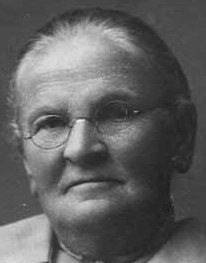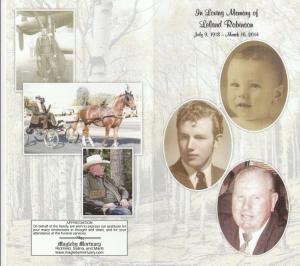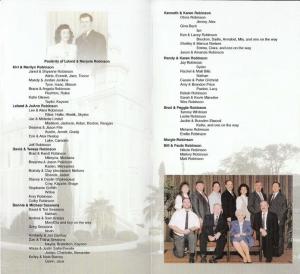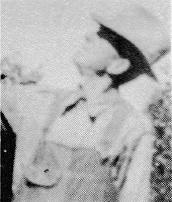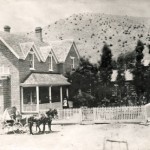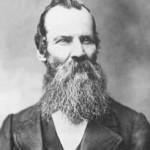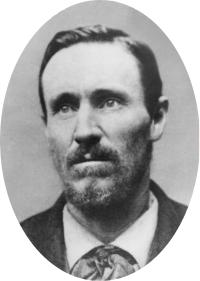Samuel Walter Jarvis
(1855-1923)
Samuel Walter Jarvis, third son and fifth child of George and Ann Prior Jarvis, was born in London, England, on April 18, 1855. When he was less than three years of age, his parents emigrated to America, staying in Boston, Massachusetts, until means could be obtained to enable the family to join the Saints in Utah.
In his 6th year he walked much of the distance across the plains carrying his two-quart brass bucket, as each member of his family was responsible for some article of their few prized possessions.
At the October conference of 1861, his father answered President Young’s call for volunteers to settle the Dixie country. This is said to have been one of the hardest pioneer settlements to develop. Here it was that Samuel grew up under adverse circumstances, learning early to work and take responsibility. Clothing was scant and food meager, and he helped provide it by killing rabbits and shooting wild ducks and geese in season along the Virgin River. At times his trousers were made of wagon covers, and he often reversed them to get maximum wear. He delighted to tell of one pair his mother made from buckskin. Early one morning while shooting ducks, he had to wade into the river to retrieve them. Soon his pants were much too long. Boy-like, he cut them off, and soon cropped off a second piece. By the time he reached home, the trousers had dried and the buckskin had shrunk until they were skintight and far too short, much to his mother’s consternation.
With practically no formal schooling, his knowledge came principally by observation and hard knocks. He was fortunate, however, in that he parents used correct English, and he learned how to express himself clearly and fluently, as well as obtaining a meager knowledge of the three “R’s,” which stood him in good stead throughout his life.
He had contact with the Ute and Paiute Indians, and learned their customers and some of their language. This helped him in his dealings with the Arizona Indians and with Mexicans in later years. For a season in young manhood, he worked for George Q. Cannon in Salt Lake City. While living with this family, he advanced rapidly in knowledge of the Gospel.
On December 4, 1877, he married Frances Godfrey Defriez, an English girl, in the St. George Temple. Shortly after their marriage they were called as pioneers to help in the establishment of settlements in northern Arizona. Consequently their first tow children were born in Snowflake. They later lived in Taylor and Nutrio Ozo (now spelled Nutrioso).
In the early spring of 1885, with their family of three boys, Samuel Walter, Jr., George Josiah, and William Heber, they answered a request to cast their lot with a company of Saints seeking refuge from the officers of the law and hoping to establish homes in Mexico. By prearrangement those leaving were to meet in Luna Valley, some miles distant from Snowflake, and travel all together by way of Silver City and Deming, New Mexico, where they were able to replenish their food supply and otherwise outfit themselves for the journey,. Here also they caught up with a company captained by Lot Smith. After experiencing such things as ten inches of snow on the mountain roads of Arizona, tracking and recovering stolen horses, a near skirmish with bandits, prairie fires, and trouble with natives, they finally arrived at “Mormon Camp” near Ascension, Mexico. Ascension was at that time the custom house, or official port of entry. Here the immigrants camped on the Casas Grandes River under some cottonwood trees while legal negotiations were underway for obtaining land. These negotiations took many months to complete. Meanwhile, the men rented land from the native farmers or share cropped where possible in order to raise food for the coming winter. Within weeks of their arrival, on May 2, 1885, a daughter, Frances was born to Samuel W. and Frances G. D. Jarvis.
After an early harvest of corn, beans, and a good quantity of other foodstuffs, they joined an organized company which moved up the river to what was known as “Old Stink Town,” where a dam was built on the Piedras Verdes River. A ditch was dug to irrigate what is now known as Cuahtemoc, which is presently owned by Mexican farmers, they yielded very good crops. A stockade was built in which meetings in religious worship were held.
Dugouts along the river helped house the company. Meanwhile a town was laid out, and holes were dug for planting shade trees along the sidewalks. During one Sunday service, Apostle Erastus Snow, standing on the platform extended his right hand over his left shoulder, declared, “There are those under the sound of my voice who will live to see the day when this (the territory embraced by the half-circle) will become one of the brightest stars in the galaxy of stars.” (This can be interpreted but one way i.e., starting at Mazatlan and ending at Veracruz, draw an arc across the Republic of Mexico and see what happens.)
Because of the ill health of his wife and baby girl, the family was advised by Apostle Erastus Snow to return to St. George for an extended visit to their parents. He took his eldest son, Sam, along and they traveled by wagon by way of Lordsburg, New Mexico and Mesa, Arizona, crossing the Colorado at Johnson’s ferry, then on to St. George. They arrived just before Christmas, 1886.
Early in the journey, his wife was thrown from the spring seat and run over by both wheels, which pressed over her body from right shoulder to left hip. She was driving the team down a sliding, sandy bank, while he and Sam walked. He realized the seriousness of the situation, and in humble prayer told the Lord that He could have the expected child if he would spare the life of his wife. During the remainder of the trip she was confined to her bed in the wagon box. On May 4th 1887, a baby girl, Amelia, was born, and died quite suddenly in September. They resigned themselves to the loss, knowing she was a promised child.
Sam and his son spent the summer months hauling wood for the Silver Reef Mining Company. In October 1887, taking grandmother Baker, who was blind, with them, they began their trip to Mexico, traveling by way of Lee’s ferry and arriving at Colonia Juarez shortly before Christmas. Apostle George Teasdale was by this time in charge of the colonies and called Sam to help settle the mountain colonies. They were the sixth family to settle at Corrales. The other families were: Franklin Spencer, Eddie Durfee, William Wallace Haws, Merit Howard Stahle, and James Palmer. While the Jarvis family lived there, three more children were born: Grace, Nephi, and Clementine. He was Sunday School Superintendent, and meetings were held in his two-room log house.
In a few years Colonia Pacheco, a few miles distant, grew to be the central mountain colony. A frame meetinghouse had been erected and surrounded with a high log fort as a safety precaution against invading Indians. In the same building a school was begun. There had been only short terms held in private homes until then. In early summer of 1894, he bought Brother Moffett’s place and moved his family from Corrales to Pacheco, at which place his son Lehi was born. The few animals they brought with them to Mexico had by this time increased to a good-sized heard and quite a band of horses. Caring for these and farming took up most of father’s time. Most of the cows, except those milked for home consumption, were loose on the range and brought in only during the rainy season, when the whole country was a waving meadow of grama grass. At this time, the calves were branded and butter and cheese made in abundance. The butter was put into molds, preserved in a barrel of brine, and kept for winter use. Cheese and potatoes were hauled to Chihuahua City or Deming, New Mexico, in exchange for cloth, sugar, salt, shoes, nails, leather, and other necessities.
Samuel was a great scout, and when the colonists’ animals were stolen he tracked them down. He was also a leader in time of Indian trouble. He was fearless, courageous, brave, and daring. He was a man of great faith, yet humble, prayerful, and blessed with intuition and spiritual inspiration, which made him equal to any situation.
He was often asked to give readings, make a stump speech for various celebrations, or take parts in plays. He was a leader in direct public work such as road, canal, or dam building. He was never idle, working daily even on stormy days, when he mended harnesses, repaired shoes, shelled corn, sorted potatoes, or made hair ropes. If ever there came a leisure moment, it was spent in reading and study. In this way he gained understanding of the scriptures and familiarized himself with the Spanish language. He loved sports, and was quite a wrestler and foot racer. Ever mindful of greater opportunities for his family, in November, 1896, he moved to Colonia Juarez, where schools and social conditions were more desirable for growing children. This move made possible the purchase of a reed organ from Annie Williams, which gave added pleasure to Grandma Baker who, though blind, had been a music teacher and played beautifully from memory. While living in Juarez, two more sons, Joseph D. and Benjamin Charles, were born. At this time he took railroad contracts, the first being in the states of Durango and Coahuila, where he employed native laborers. It was during this time the young man, Manrique Gonzalez, was hired. He proved to be desirable help and was given a home with the Jarvises, where he helped care for the horses. They finish the contract after being gone the greater part of the year, then returned to Juarez, bringing Manrique with them. Manrique found a home with Patriarch Stowell, attended school, and afterward joined the Church.
Almost immediately after the return from the railroad contract, Samuel Jarvis was called by Stake President Anthony W. Ivins to go to Sonora and help open up settlements there. He took the older boys, but left the remainder of the family. In due time, after the Pioneer Canal was finished in Colonia Morelos, fields cleared and fenced, and cultivation began, he asked for release, not wanting to take Grandmother Baker there. President Ivins felt the time was not ripe for such a measure. The rest of the Jarvises were moved to Colonia Morelos. Samuel W., Jr. was married, and George is on a mission to the Central States. In Morelos, Samuel Sr. Set up a grocery store, which his wife managed while he spent the greater part of his time on the road freighting. All merchandise was purchased in Colonia Dublan, until Douglas, Arizona, came into being. In rainy seasons, with their washed out roads, high waters, and mud holes, it sometimes took two weeks to make the round-trip, which is double the usual time. This, together with attempting to farm and look after cattle, was taxing to both body and mind. Under these conditions their 12th child, Mary Esther, was born.
The fall of 1905 came what is known as the “Great Flood.” After a week of continuous rain, the Bavispe River rose to unprecedented heights, destroying the dam and canal systems from both sides of the river and washing away and cutting up fertile fields, destroying all the crops. This act of nature forced practically every male member of Colonia Morelos to seek means of support elsewhere. A railroad line being extended from Naco to Nacozari offered a solution in the form of jobbing and freighting. Here it was that Samuel married his second wife, Pearl Dean Taylor. With his father-in-law, Edwin A..Taylor and family from Colonia Juarez, the two men ran a butcher shop that season in Nacozari. Camped at Calabasa Flat, Pearl’s first son, Hyrum Taylor, was born.
When the railroad was completed, Samuel returned to Colonia Morelos and, with others, opened new fields north of town on the Batepito River where farming was resumed. In May, 1906, Pearl second son, Edwin Walter, was born in Colonia Morelos. In the summer of 1907, Samuel made a trip to St. George, Utah, accompanied by his wife Pearl, their two young sons, and his daughters Frances and Grace to attend Will’s temple marriage and visit Samuel’s parents. He returned to Colonia Morelos in early October.
In the spring of 1908 he was given his release as a colonizer from President Ivins and moved his families to Colonia Dublan, where, on June 16, Pearl’s third son, Brigham Taylor, was born. Some months later Samuel purchased the Frank Wall terreno (large field) in Guadalupe, about 10 miles up the river from Dublan, where he again took up farming. Here their daughter Pearl was born on April 24, 1910. Prior to her birth, Samuel took a contract building a railroad, as the Noroeste was extending its road from the vicinity of Casas Grandes to Madero via Pearson and El Rucio.
Revolutionary movements were already brewing in Chihuahua, the effects of which brought about the Exodus from Mexico in 1912. At that time all the women and children of the Chihuahua colonies were taken to El Paso on freight cars. Finding themselves dependent on the United States government or other charities, many of the colonists accepted transportation arrangements by the Church and the railroads so they could go where they had relatives. The men came out overland on horseback, joining their families as soon as possible. Samuel Jarvis took his families and went to St. George, Utah for a season. Here, on October 15, 1915, Ernest Van Buren was born. After attending October conference in Salt Lake City, Samuel returned to Mexico and brought teams and wagons out to Arizona. He stopped at Saint David, Arizona and traded a team and wagon for a 40-acre homestead near the Whetstone Mountains, southwest of Benson. This area was called Miramonte. Here another shack was built to “prove” this property.
As life was rigorous and they had little to work with, being forced to relive pioneer experiences, food was plain and simple. In order to receive proper care, Pearl went to El Paso for the birth of Bessie Ann on March 15, 1916. After some six years of difficult living, helping to build dams on the San Pedro River, enlarging the Benson canal, clearing and bringing under cultivation new land and hoping to better his condition, Samuel exchanged his holdings in San Pedro Valley (Benson) for land under new irrigation system near Ysleta, Texas. Only months after living there, Pearl was a victim of the influenza epidemic in the spring of 1919, leaving her small children to the care of Frances, Samuel’s first wife. The water in Ysleta was blamed for Samuel’s own failing health, so he moved his wife Frances and his young family back to Colonia Dublan, Mexico. However, he never regained his health, and passed away after considerable suffering on February 7, 1923, leaving Frances and Lehi to care for the children. He was buried in the Dublan cemetery on February 9, 1923.
Samuel Walter Jarvis, Jr., son, and Grace Fenn, daughter
Stalwarts South of the Border page 329

